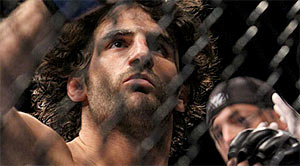
MMA Weight Classes
At present, as per the Unified Rules of Mixed Martial Arts, there are nine different weight classes. They are as follows:
1. Flyweight under 125.9 lbs.;
2. Bantamweight 126 lbs. – 134.9 lbs.;
3. Featherweight 135 lbs. – 144.9 lbs.;
4. Lightweight 145 lbs. – 154.9 lbs.;
5. Welterweight 155 lbs. – 169.9 lbs.;
6. Middleweight 170 lbs. – 184.9 lbs.;
7. Light Heavyweight 185 lbs. – 204.9 lbs.;
8. Heavyweight 204 lbs. – 264.9 lbs.; and
9. Super Heavyweight over 265 lbs..
Most just round the numbers to show them this way:
1. Flyweight 125 lbs. and under;
2. Bantamweight 135 lbs.;
3. Featherweight 145 lbs.;
4. Lightweight 155 lbs.;
5. Welterweight 170 lbs.;
6. Middleweight 185 lbs.;
7. Light Heavyweight 205 lbs.;
8. Heavyweight over 205 lbs.; and
9. Super Heavyweight over 265 lbs..
But in reality they are wrong…
It’s just easier to say and show them that way on television and in conversation. At least that is my explanation as I took the information from Sub Chapter 24A (or to be more precise: 13:46-24A.1 Weight classes of mixed martial artists) of the New Jersey State Athletic Control Board Regulations for the sport for the first list. Other jurisdictions have mostly adopted these weight classes as well.
The finer details of the discrepancies between what has become common language to television watchers and what the regulations state I’ll leave for another time as it is not the point of this article. I just thought the information would be useful as a starting point for what I will argue in the following paragraphs below. I will also use the second set of weight classes in my argument for the same reason as everyone else, that is ease of use.
As the title indicates, it is time for the world of MMA, in my opinion, to change its weight class designations. What I suggest isn’t a radical change but a relatively minor one and it only involves the Heavyweight and Super Heavyweight divisions.
If you look at the weight classes as they presently stand you see a pattern develop. If you start at the smallest, flyweight (125 lbs.), you see ten pound increases as you jump up in weight. Once you hit welterweight the jump to middleweight is 15 lbs., then 20 lbs. to light heavyweight. Lastly, you see a huge jump of 60 lbs. to reach super heavyweight.

Presumably the larger increases as you rise in weight class has to do with the human body’s structure. Meaning as weight classes rise the difference in weight between one fighter and another becomes less significant. The logic of this premise means a featherweight would has the exact same advantage over a bantamweight due to his extra 10 lbs. that a light heavyweight has over a middleweight with his 20 lbs.
Whether this is true or not, and there are arguments on both sides, it is easy to see that this does not apply to the heavyweight division. There is 60 lbs. of room within this weight class and routinely the bigger guy wins. If you go back in time when weight was less important than skill, smaller men could beat larger ones on a regular basis using better techniques and game plans. But that time has long since passed.

Fedor Emelianenko
What you have presently is two types of heavyweights. The natural heavyweight such as Randy Couture, Antônio Rodrigo Nogueira, Fedor Emelianenko, Mirko Cro Cop and others around the 220-235 lbs. range and the larger heavyweights who are naturally around the 240-265lbs. range such as Brock Lesnar, Shane Carwin, Cain Velasquez, Matt Mitrione and Antonio Silva.
Although it is fun to watch the exceptional fights at heavyweight where the lighter guy triumphs, mostly what you see is the bigger man over-power the smaller and take home a relatively easy win. What this has resulted in is many natural heavyweights dropping 20-30 lbs. to fight in the light heavyweight division (such as Couture) or face being out weighed by much larger men (such as happened to Cro Cop among others).

Josh Barnett
The heavyweight division has always been over-crowded with fighters, whether looking at the
UFC, STRIKEFORCE, or the other promotions around the world and it isn’t because big men enjoy fighting more than their smaller counterparts. The reason is because truthfully the division is actually two divisions in one. It’s no coincidence that in the history of the UFC there has been a total of one super heavyweight fight since modern weight classes were first used (that between Josh Barnett and Gan McGee at UFC 28). It’s because the natural super heavyweights all fight in the heavyweight division.

Each time the UFC saw that its competition was being raised it formed new divisions. As the sport became more popular, the number of professional fighters both increased and improved, and weight started to be an important factor in the outcome of fights. New divisions were a necessary evolution and the UFC responded. Now is the the time to continue that progression. Although there is no need to add another weight class to MMA, there is a need to modify two of its divisions to reflect the physical nature of their fighters. Hence the super heavyweight division should lower its weight requirements to the 235 lbs. range.
The super heavyweight division has always been a vacant weight class. Which seems like a shame to this writer. The Brock Lesnars and Shane Carwins of the world deserve their own division rather than fighting men much smaller than themselves and calling it a fair fight.
![Newsted’s Metal Is More Metal Than Metallica [VIDEO]](https://www.yellmagazine.com/wp-content/uploads/2013/01/newstead-thumb.jpg) Newsted’s Metal Is More Metal Than Metallica [VIDEO]Former Metallica bass-man, Jason Newsted, is back with a four-track solo… »
Newsted’s Metal Is More Metal Than Metallica [VIDEO]Former Metallica bass-man, Jason Newsted, is back with a four-track solo… »![UFC 158: Nick Diaz Interview “I’m The Only Real Deal” [VIDEO]](https://www.yellmagazine.com/wp-content/uploads/2013/01/nick-thumb.jpg) UFC 158: Nick Diaz Interview “I’m The Only Real Deal”Nick Diaz was definitely alive and well at the UFC 158 press conference to… »
UFC 158: Nick Diaz Interview “I’m The Only Real Deal”Nick Diaz was definitely alive and well at the UFC 158 press conference to… »![Machine Head – Live At Rock Am Ring (2012) [VIDEO]](https://www.yellmagazine.com/wp-content/uploads/2013/01/machine-head-thumb.jpg) Machine Head – Live At Rock Am Ring (2012) [VIDEO]Formed in 1991, just as grunge exploded its emotional guts all over the… »
Machine Head – Live At Rock Am Ring (2012) [VIDEO]Formed in 1991, just as grunge exploded its emotional guts all over the… » Trek Wars? J.J. Abrams To Direct Star Wars, Episode VIIJ.J. Abrams To Direct Star Wars, Episode VII It seems that Disney's… »
Trek Wars? J.J. Abrams To Direct Star Wars, Episode VIIJ.J. Abrams To Direct Star Wars, Episode VII It seems that Disney's… » Authority Zero – Free “No Other Place” DownloadAuthority Zero Hermosa Beach’s burgeoning indie label Hardline… »
Authority Zero – Free “No Other Place” DownloadAuthority Zero Hermosa Beach’s burgeoning indie label Hardline… »
















